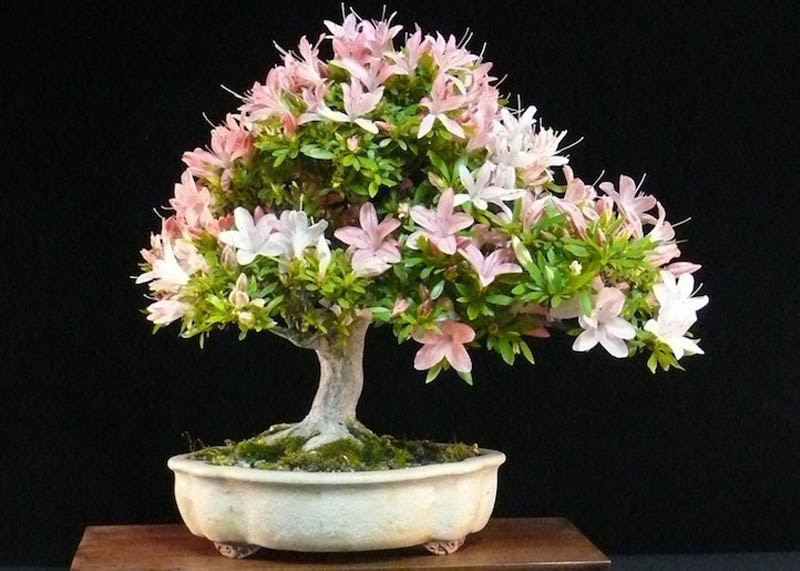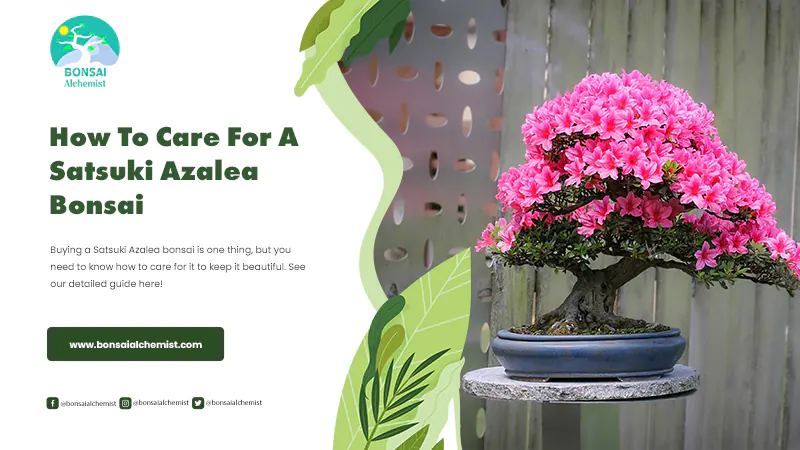If you’ve ever been captivated by the beauty of Satsuki Azalea Bonsai, then you’re in for a treat. In this article, we’ll delve into the world of caring for these magnificent plants, providing you with tips and techniques that will help you maintain their health and vibrancy.
From styling to flowering, we’ll cover it all. Plus, we’ll answer some commonly asked questions, such as whether Satsuki azalea bonsai can be kept indoors, how long they live, and how much sun they need. So, without further ado, let’s jump into the wonderful world of Satsuki Azalea Bonsai care.
Caring for Satsuki Azalea Bonsai: Tips and Techniques
When it comes to caring for a Satsuki azalea bonsai, there are several important factors to consider.
From choosing the right soil and watering techniques to pruning and protecting from pests, proper care is essential for the health and longevity of your bonsai. In this article, we will explore the various aspects of caring for Satsuki azalea bonsai, providing tips and techniques to help you ensure the success of your miniature tree.

How to care for a Satsuki azalea bonsai
Caring for a Satsuki azalea bonsai starts with selecting the right soil. Rhododendron bonsai soil is ideal for Satsuki azaleas as it provides the necessary drainage while retaining moisture. You can also mix in some organic soil amendments to improve fertility and structure. When repotting, it is important to prune the roots and ensure they are properly spread out in the new pot.
Watering techniques for Satsuki azalea bonsai are crucial for their health. These bonsai plants prefer moist but not waterlogged soil. It is important to water them regularly, especially during warmer months, but always allow the top layer of soil to dry out slightly before watering again. Overwatering can lead to root rot, while underwatering can cause the plant to wilt and suffer.
In terms of fertilizing, it is recommended to use a balanced, slow-release bonsai fertilizer during the growing season. This will provide the necessary nutrients for healthy growth. Additionally, periodic application of a high phosphorus fertilizer will help promote flowering.
Pruning and shaping Satsuki azalea bonsai is a crucial aspect of their care. Regular pruning helps maintain the desired shape and encourages branching. It is best to prune in early spring before the new growth starts. This will promote back-budding and result in a more compact and aesthetically pleasing bonsai. However, be careful not to prune too heavily, as azaleas can be sensitive to excessive pruning.
Protecting Satsuki azalea bonsai from pests and diseases is essential for their overall health. Common pests that can affect azalea bonsai include aphids, scale insects, and spider mites. Regularly inspect your bonsai for any signs of infestation and take appropriate measures to control them. Additionally, keeping good airflow around the bonsai and avoiding excessive watering can help prevent fungal diseases.
Keeping Satsuki azalea bonsai indoors
While Satsuki azaleas can be kept indoors, they require specific care to thrive in an indoor environment. Creating an ideal environment for indoor Satsuki azalea bonsai includes providing adequate sunlight, maintaining proper humidity, and ensuring good air circulation.
Indoor Satsuki azalea bonsai need bright, indirect light to flourish. Place them near a window that receives bright, filtered sunlight for several hours a day. If natural light is limited, supplement with artificial grow lights to meet their requirements.
Maintaining proper humidity is crucial for indoor Satsuki azalea bonsai. These plants prefer higher humidity levels, so consider using a humidity tray or misting the foliage regularly to increase humidity around the bonsai. Avoid placing them near drafts or heaters, as these can dry out the air.
The lifespan of azalea bonsai
The lifespan of azalea bonsai can vary depending on various factors. With proper care, Satsuki azalea bonsai can live for several decades. However, it is important to note that bonsai are living organisms and their lifespan is ultimately determined by their overall health, genetics, and environmental conditions.
Factors that can influence the lifespan of azalea bonsai include the quality of care provided, protection from pests and diseases, and the genetic predisposition of the tree. To prolong the lifespan of your azalea bonsai, ensure it receives proper nutrition, water, and sunlight, and take proactive measures to protect it from pests and diseases.
Choosing azaleas for bonsai
Not all azaleas are suitable for bonsai cultivation. When choosing azaleas for bonsai, it is important to select the right variety. Satsuki azaleas (Rhododendron indicum) are popular choices for bonsai due to their small leaves, beautiful flowers, and ability to tolerate pruning and shaping.
Considerations for azalea bonsai cultivation include selecting a healthy and vigorous specimen with good branch structure. Look for well-established root systems and avoid trees with excessive root rot or damage. Additionally, choose azaleas with desirable flower color and forms that will enhance the aesthetic appeal of your bonsai.

Sunlight requirements for Satsuki azalea
Satsuki azaleas require a balance of sunlight to thrive. Understanding their sunlight needs is crucial for their overall health and flowering. These bonsai plants thrive in bright, filtered sunlight. They should receive at least 4-6 hours of indirect sunlight daily.
Finding the right balance of sunlight for Satsuki azalea bonsai is important. Too much direct sunlight can scorch the leaves and cause leaf burn, while too little sunlight can result in weak growth and poor flowering. Position your bonsai near a window that receives bright, filtered sunlight or provide supplemental grow lights to meet their needs.
Size of Satsuki azalea bonsai
Managing the size of Satsuki azalea bonsai is essential for maintaining their aesthetic appeal. Pruning is the main technique used to control the size and shape of these bonsai plants. Regular pruning helps maintain the compact form and encourages branching.
Controlling growth to maintain the desired size of Satsuki azalea bonsai involves regular pruning and pinching of new shoots. Additionally, root pruning during repotting helps manage the overall size of the bonsai. By carefully monitoring and pruning the growth, you can control the size and shape of your Satsuki azalea bonsai.

Watering frequency for azalea bonsai
Determining the optimal watering schedule for azalea bonsai is crucial for their health. These plants prefer moist but not waterlogged soil. It is important to water them regularly, especially during warmer months when they are actively growing.
The frequency of watering azalea bonsai depends on various factors such as ambient temperature, humidity levels, and the moisture retention capacity of the soil. As a general guideline, check the top layer of soil with your finger. If it feels slightly dry, it is time to water. However, avoid allowing the soil to completely dry out, as this can stress the bonsai.
Signs of overwatering in azalea bonsai include yellowing leaves, root rot, and a damp and musty smell. On the other hand, signs of underwatering include wilted leaves, dry and crispy foliage, and a dry and cracked soil surface. It is important to find the right balance and adjust the watering frequency accordingly.
Longevity of azalea bonsai
The longevity of azalea bonsai can vary depending on several factors. Factors that can affect the longevity of azalea bonsai include the overall health and care provided, protection from pests and diseases, and genetic predisposition. With proper care and maintenance, azalea bonsai can live for several decades.
To extend the life of your azalea bonsai, provide it with proper nutrition, water, and sunlight. Regularly inspect your bonsai for any signs of pests or diseases and take immediate action to control them. Prune and shape your bonsai regularly to maintain its health and aesthetic appeal. By incorporating these tactics, you can increase the lifespan of your azalea bonsai.

Styling techniques for Satsuki azalea bonsai
Styling a Satsuki azalea bonsai is an art form that involves shaping and training the tree to achieve a desired aesthetic. There are several styling techniques that can be used to enhance the visual appeal of your bonsai.
One common styling technique for Satsuki azalea bonsai is pruning. Regular pruning helps maintain the compact form and encourages back-budding. This results in a more dense foliage and a more refined overall appearance. Use sharp bonsai shears to carefully remove excess growth and maintain the desired shape.
Wiring is another technique that can be employed to style Satsuki azalea bonsai. By carefully wrapping bonsai wire around the branches, you can guide their growth and create the desired shape. However, caution must be exercised when wiring azaleas, as their branches can be brittle and prone to damage.
Additionally, pinching and defoliation can be used to promote ramification and fine branching. Pinching involves removing the terminal buds of new growth, which redirects energy to lateral buds. This helps create a more dense and ramified bonsai. Defoliation, on the other hand, involves removing a portion of the foliage to encourage smaller leaves and increase the overall aesthetical appeal.
Promoting flowering in azalea bonsai
Flowering is one of the most desirable traits of azalea bonsai, and promoting their blooming requires specific care and techniques. To encourage flowering in your azalea bonsai, it is important to create optimal conditions that mimic their natural habitat.
Creating optimal conditions for azalea bonsai to bloom involves providing them with the right amount of sunlight, temperature, and humidity. Satsuki azaleas require bright, filtered sunlight to bloom profusely. Position your bonsai near a window that receives ample sunlight or use artificial grow lights to supplement their light requirements.
Temperature is another key factor in promoting flowering. Satsuki azaleas require a period of cool temperatures, typically around 40 to 50 degrees Fahrenheit, for several weeks in late autumn or early winter. This helps induce the formation of flower buds. However, be careful to protect the bonsai from freezing temperatures, as it can cause damage.
Maintaining proper humidity levels is also important for flowering. Satsuki azaleas prefer higher humidity levels, so consider using a humidity tray or misting the foliage regularly to increase humidity around the bonsai.
In conclusion, caring for a Satsuki azalea bonsai requires attention to detail and specific techniques. From choosing the right soil and providing adequate sunlight to pruning and promoting flowering, following these tips and techniques will ensure the health and longevity of your bonsai. With patience and care, you can enjoy the beauty of these miniature trees for years to come.



